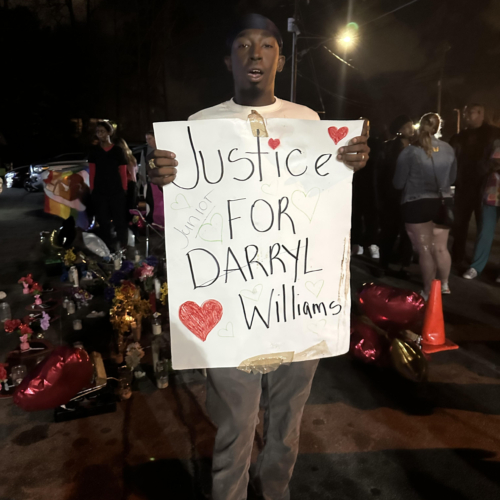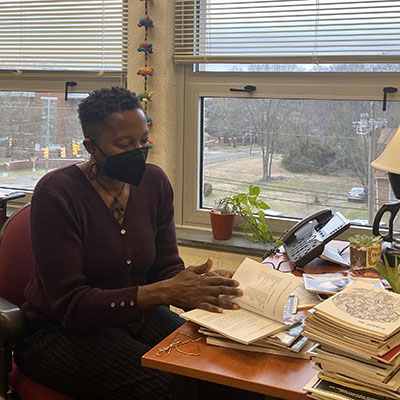This story originally ran on Indyweek on February 1st.
Darryl Williams, 32, was tased to death by Raleigh police on January 18 while unarmed and attempting to flee.
Lovingly referred to as “Boo Boo,” Williams is one of more than 1,000 people who have been killed by police with tasers since 2000. More than 90 percent of these people were unarmed.
Kayla Boyd, who says she was a witness to the killing, spoke at Williams’s vigil in Raleigh last week. She said he was tasered multiple times, his body left out for two hours, and, despite police claims in the Five Day Report, that police made no legitimate attempt to resuscitate him. WRAL reported that Williams died in the hospital, but Boyd and others say he died on the scene. Williams is remembered as a beloved member of the Triangle’s LGBTQ+ community.
In 2020, 94 percent of America’s roughly 18,000 police agencies issued tasers, largely embraced as a less lethal alternative to firearms. The common justification among police departments, Durham Police Department included, for the use of tasers and other “nonlethal” or “less than lethal” weapons is that they reduce the rate of officer and subject injuries and deaths.
And it makes sense: Who wouldn’t assume a taser is a safer alternative to a handgun?
But the killing of Darryl Williams and other victims raises the question of whether such weapons are actually effective in reducing injury and death in conflicts with police.
In 2005, just a few years after tasers were deployed to police departments, and a slew of police killings followed, manufacturer Axon (formerly known as Taser International) dropped the “nonlethal” characterization. The fact that tasers and other conducted energy devices (CEDs) are not designed to kill by no means determines that they will not kill in the hands of a police officer. A knee need not kill, but that did not stop Daniel Pantaleo from using it to kill Eric Garner or Derek Chauvin using it to kill George Floyd. Switching a handgun out for a taser, a stun gun, or even a rubber duck does not reduce the killing capacity or absent accountability of police.
In a single tase, victims are administered a 50,000-volt shock followed by 100 microsecond pulses of 1,200 volts. Research has demonstrated that their improper use, which already stands upon shaky definition, can cause significant injury, cardiac arrest, loss of consciousness, seizures, abnormal brain activity, or death. The incomplete understanding of the efficacy and safety of tasers and CEDs, or conducted energy weapons (CEWs), leads us to question how we can justify their use. Research on their physical and psychological impacts is evidently inconclusive, experts state. The scope of the data falls incredibly short given that existing research claiming the safety of tasers and CEDs/CEWs has only included subjects who can be described as healthy, nonstressed, and nonintoxicated and followed their “recommended use.” One would be hard pressed to find someone in an altercation with police to be “nonstressed.”
Tasers and CEDs are used widely while their effects are not understood on disabled or ill people or people using drugs or alcohol. This points to a huge ethical flaw in their use. Despite the fact that there is little to no research on the effects of CEDs on small children, the elderly, pregnant women, and other potentially at-risk individuals, there are no laws against using such weapons on them. The existing gaps in data are compounded by the fact that Black people, who are more likely to experience heart disease, other people of color, and people experiencing mental and behavioral health crises disproportionately experience use of force by law enforcement.
There are also very minimal restrictions around taser use by law enforcement agencies. Despite the fact that Axon Corporation discourages prolonged or continued exposure, there are no laws or regulations stopping Raleigh police (or most police departments) from using tasers this way. Investigations have demonstrated that many officers are not properly trained on proper use and potential risks and often misuse the weapons. Despite the fact that tasing time is recommended to be no longer than 15 seconds, the M26 and the X26 (Axon’s most popular models) can be repeated countless times with indefinite charge.
Since the early 2000s, several federal courts have offered warnings about the “excruciating pain” they find tasers cause. In Armstrong v. Pinehurst, courts ruled that physical resistance or attempts to flee did not warrant CED use. Instead, CEDs are only meant for use to protect an officer or third party from an immediate threat of harm. These rulings mean that the taser death of Williams, who was unarmed and fleeing as witnesses say, should be designated a criminal offense. Despite this court ruling, a review of nationwide tasing incidents resulting in death show that 80 percent of cases began as nonviolent incidents, with 84 percent of the people being unarmed. We have seen over and over again that police will use their weapons to the extent and frequency that they desire. And in Williams’s case, the police seemingly wanted to kill.
The Raleigh Police Department’s budget is over $124 million per year, far more than any other city department. Refund Raleigh, a grassroots organization, is demanding that the Raleigh City Council divest from Raleigh PD and instead invest in meaningful social programs that actually keep Black and working-class people safe. The group, in a recent statement on Williams’s death, writes, “Our communities are suffering from lack of investment, affordable housing, health care, fair wages, childcare, and quality education—all public services our tax dollars are supposed to be funding. Yet, cities’ answer to these problems is just to spend hundreds of millions of our tax dollars on policing our communities.”
In 2020 local grassroots organization Durham Beyond Policing launched and won a campaign canceling a $626,910 taser contract between Durham Police Department and Axon Corporation. The deaths of Darryl Williams, Keenan Anderson, Eurie Martin, Manuel Ellis, Thomas Sadler, Everette Howard, Darryl Wayne Turner, and countless others remind us that such wins are life-saving.
Police officers’ demonstrated predisposition to kill Black people, in tandem with tasers’ and CEWs’ lethal capacity, means such weapons are no less deadly than a handgun in the hands of an unaccountable officer. Until we release ourselves from the myth that tasers will stop or reduce cops from killing, we will continue to see tasers and stun guns used to execute beloved members of our community.
Blue Miller is an organizer with Southern Vision Alliance. Nada Merghani is a senior at NC Central, editor of the school newspaper, the Campus Echo, and an organizer with Southern Vision Alliance.


















